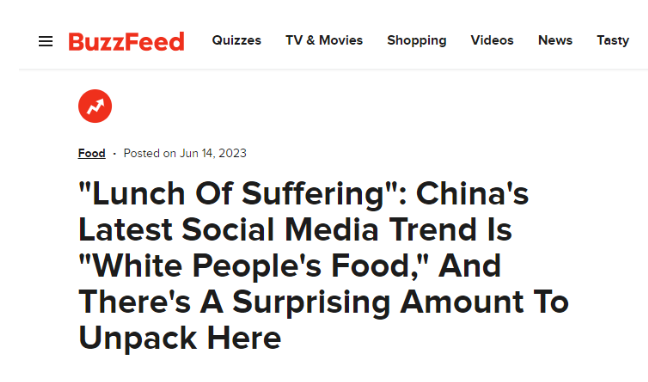外媒是如何报道火遍全网的“白人饭”的?
最近,一种名为“白人饭”的饮食方式在小红书、抖音等社交平台走红。它之所以有这样的名字,是因为这种饮食方式最初火爆起来就是源于网友晒出的外国同事、朋友的工作日午餐。
这样的午餐可以使面包夹火腿肠和奶酪、也可以是坚果和酸奶,更可以是整颗西蓝花和胡萝卜,这些食物主打简单、快捷,相较于我们常吃的沙拉和简餐,只用一个“生冷少”概括所有。
这样的发帖也引起了众多留学生的公民,纷纷加入网友模仿与调侃的队伍,随后玩起了“白人饭也是饭”“为白人饭发声”等口号。
“白人饭”的话题在微博阅读量达到500万,美国流媒体网站Buzzfeed在6月14日发表了一篇文章,《“受难餐”:中国的社交媒体趋势是“白人饭”,发帖数量惊人!》,文章中介绍了“白人饭”在中国网络上的走红。这篇文章登上了buzzfeed流行榜,点击量10万+。
BuzzFeed|: "Lunch Of Suffering": China's Latest Social Media Trend Is "White People's Food," And There's A Surprising Amount To Unpack Here “受难餐”:中国的社交媒体趋势是“白人饭”,发帖数量惊人

In recent weeks, one particular trend has taken several Chinese social media platforms by storm. At its core, it's quite literally just people posting pictures of American-style lunches — think: veggies and dips, crackers and cold cuts, sandwiches on white bread — and referring to them as "white people's food." But there's more to it than meets the eye.
最近几周,一个特殊的趋势席卷了中国的几个社交媒体平台。从本质上讲,这只是人们发布美式午餐的照片——想想:蔬菜和蘸酱、饼干和冷盘、白面包三明治——并将其称为“白人饭”。
The trend is purportedly said to have started in late May, when a Chinese woman in Switzerland posted a video of a European woman while riding a train. In the video, the European woman assembles her lunch, which consists solely of a "bag of lettuce" and "slices of ham."
据称,这一趋势始于5月底,当时一名在瑞士的中国女子发布了一段欧洲女子乘坐火车的视频。在视频中,这位欧洲妇女正在准备她的午餐,午餐只包括“一袋生菜”和“几片火腿”。
This viral video sparked a wave of online discussion in China around these "healthy" meals attributed to white people. Chinese news outlets published articles asking ex-pats for their perspectives on their colleagues' lunches, and many social media users continued to reveal the "rabbit food" lunches they were seeing daily.
这段病毒式传播的视频在中国引发了一波关于白人“健康”饮食的网络讨论。中国新闻媒体发表文章,询问海外国民对同事午餐的看法,许多社交媒体用户继续透露他们每天看到的“兔粮”午餐。
But the people allegedly responsible for turning this niche discussion into a mainstream internet event in China — which at some point adopted báirén fàn (or "white people's food") as an unofficial moniker — were young professionals, who praised how straightforward and prep-friendly these meals were. It's important to note that typical homemade lunches in China can be incredibly labor-intensive, involving many different ingredients and requiring lots of time and energy to assemble. These "trending" dishes, however, were not.
但据称,负责将这场小众讨论转变为中国主流互联网活动的人是年轻的专业人士,他们称赞这些饭菜是多么简单和方便准备。值得注意的是,在中国,自制午饭需要付出密集的劳动,涉及许多不同的配料,需要大量的时间和精力来组装。然而,这些“流行”菜肴并非如此。
For many of these young professionals, preparing "white people's food" was a welcome change of pace when cooking after a long day. A Chinese blogger wrote that they "used to love watching cooking videos and trying out new recipes," but eventually found it too tiring. "As a laborer, I don't have much free time after work," they added. It actually speaks to a more significant movement of young people fighting back against China's "996" work culture, where people work from 9 a.m. to 9 p.m. six days a week.
对于这些年轻人中的许多人来说,在漫长的一天后烹饪时,准备“白人饭”是一种受欢迎的节奏变化。一位中国博主写道,他们“过去喜欢看烹饪视频和尝试新食谱”,但最终发现太累了。他们补充道:“作为一名打工人,我下班后没有太多空闲时间。”。事实上,这反映了一场更为重要的年轻人反抗中国“996”工作文化的运动,即人们每周六天从早上9点工作到晚上9点。
On China's lifestyle-sharing app Xiaohongshu — which is kind of like Pinterest meets TikTok, as I understand it — photos and videos of people making their own "white people" lunch creations went totally viral. While captions attached to several posts appeared to poke fun at these dishes, many social media users actually expressed how pleased they were with them. One even suggested that the inherent lack of carbs helped them to stay more focused at their job and fight afternoon drowsiness.
在中国的生活方式分享软件小红书上,人们制作自己的“白人”午餐的照片和视频在网上疯传。虽然几条帖子的标题似乎是在取笑这些菜肴,但许多社交媒体用户实际上表达了他们对这些菜肴的满意。有人甚至认为,缺乏碳水化合物有助于他们更加专注于工作,对抗下午的嗜睡。
Still, amid those touting the "health benefits" and approachability of "white people's food," the trend hasn't been without its opponents. Another Chinese blogger referred to these types of meals as the "lunch of suffering." A commenter on Xiaohongshu suggested that "if such a meal is to extend life, what is the meaning of life?" And in perhaps the most scathing take out there, a Weibo user shared this caption with a photo of a Lunchables-like tray of crackers, cheese, and meat: "The point of the white people's meal is to learn what it feels like to be dead, but I've taken two bites and it was so bad it made me realize how alive I am."
尽管如此,在那些吹捧“白人饭”的“健康益处”和简单的人中,这一趋势并非没有反对者。另一位中国博主将这类餐点称为“痛苦的午餐”。小红书上的一位评论者提出,“如果这样的餐点是为了延长生命,那么生命的意义是什么?”一位微博用户分享了这段文字,并附上了一张类似午餐的饼干、奶酪和肉:“白人用餐的目的是了解死亡的感觉,但我吃了两口,味道太糟糕了,让我意识到自己是多么的活着。”
在流行趋势背后不难看出,除了社交玩梗以外,更有不少商业因素在推动。子2002年轻食概念进入中国食品消费市场后,轻食相关企业开始冒头。2015年以后,大量轻食企业涌出,轻食行业进入资本投放密集期,大量资本开始涌入轻食行业,轻食行业得到了快速的发展;2018后,由于轻食行业的发展不成熟,轻食行业进入洗牌期,资本撤退快速;这两年来我国轻食行业高潮又卷土重来,供给端轻食企业的快速增加,叠加疫情以来消费者饮食习惯的改变,轻食行业得到了前所未有的关注。
如果关注过轻食行业的行业报告,不难看出去,消费关键词在于低卡、健康,而轻食主要消费者群体为年轻人。“白人饭”从某种程度上看来同样满足消费群体的需求,相较轻食而言,成本更低,制作方式也更简单。
但是相应的,在996大环境下,密集的打工人与庞杂的劳动量不会允许打工人长期吃“白人饭”,毕竟首先发声反抗的就是自己的身体,大家觉得呢?